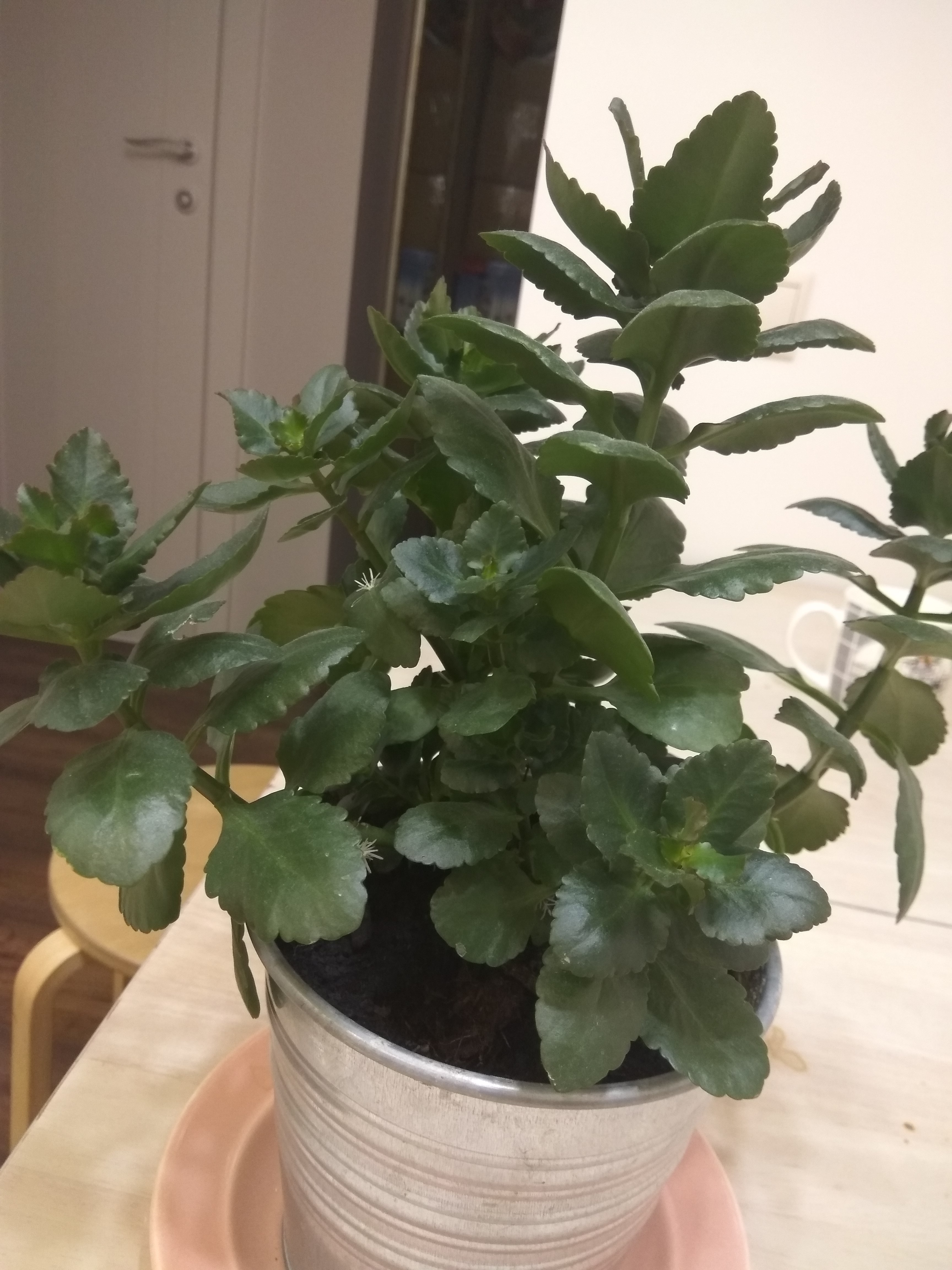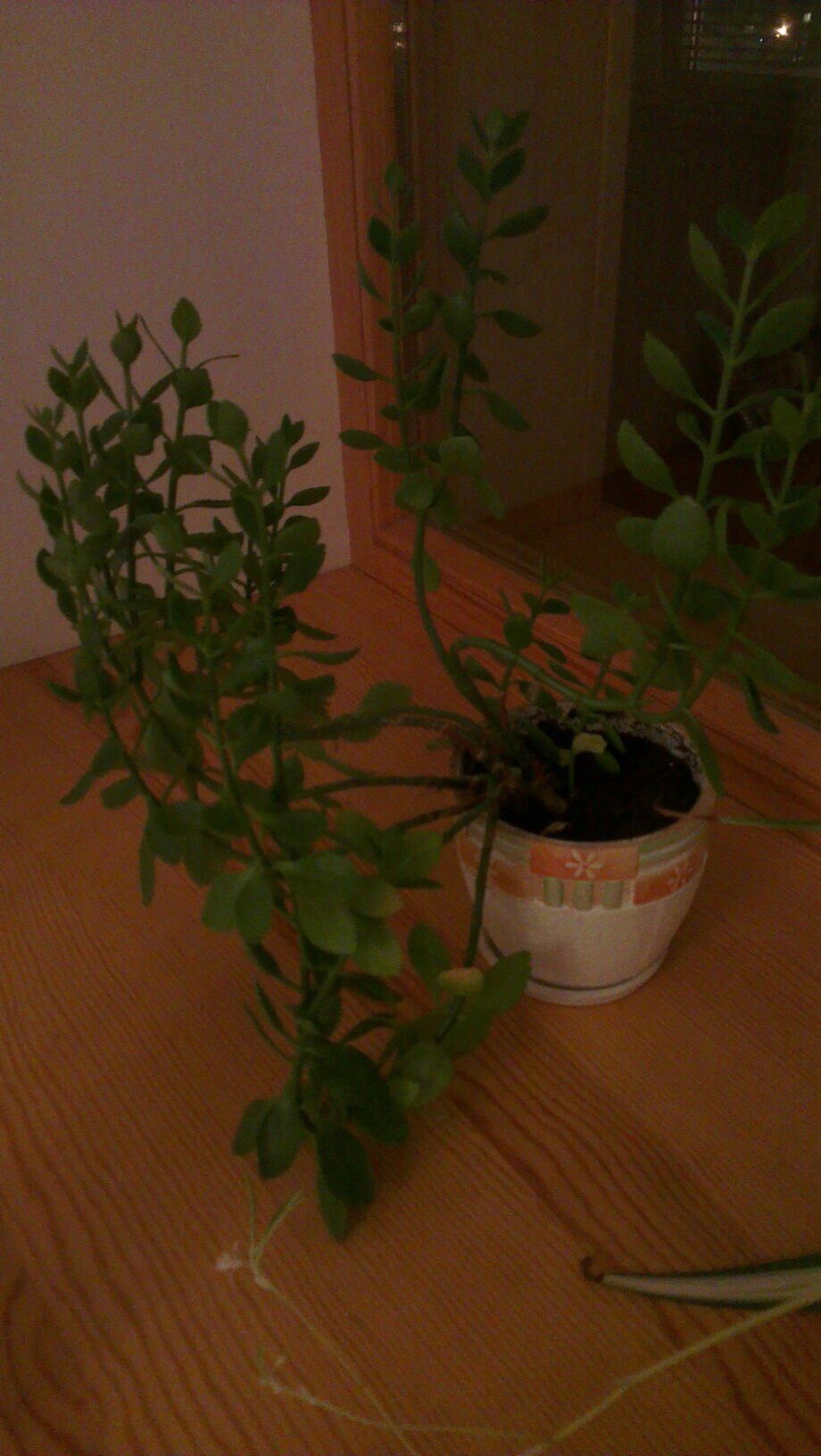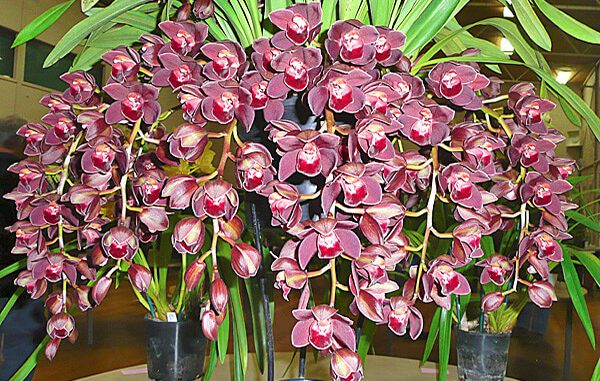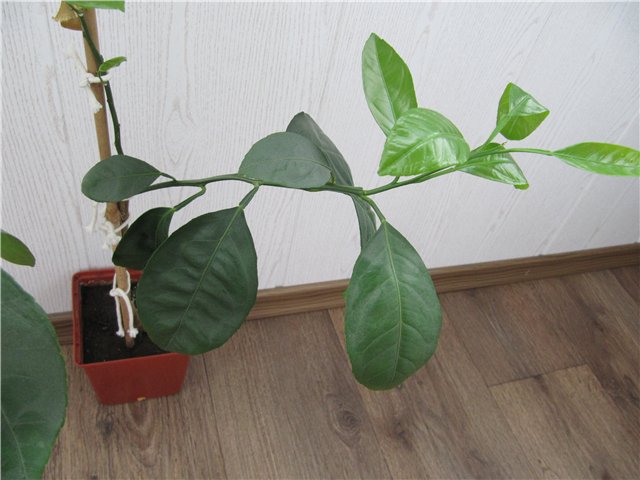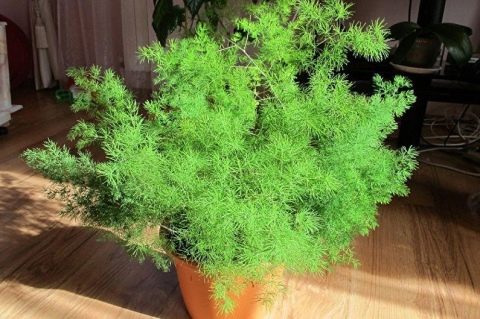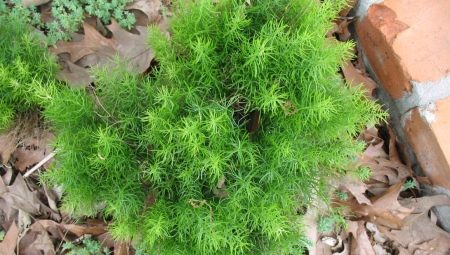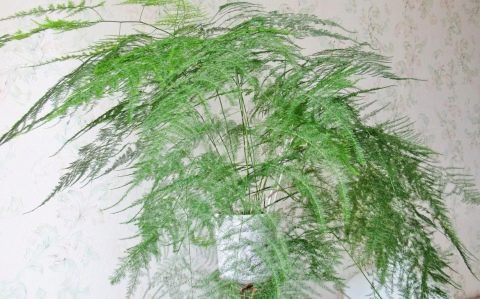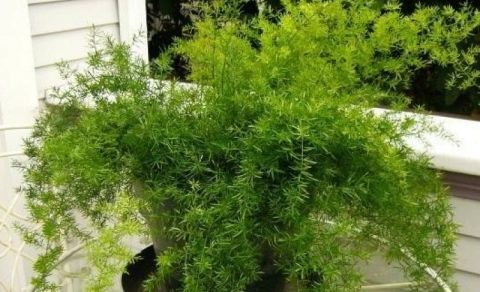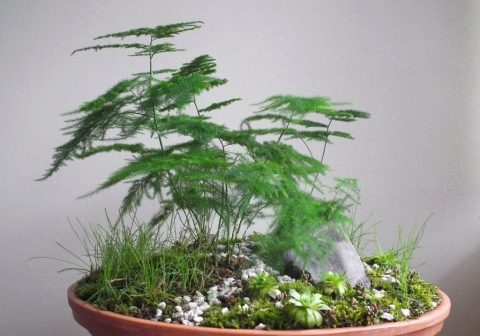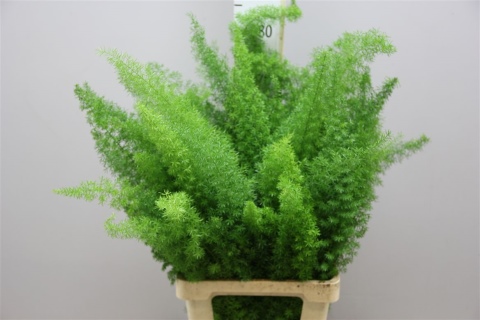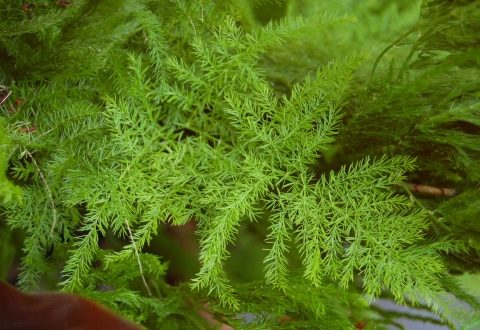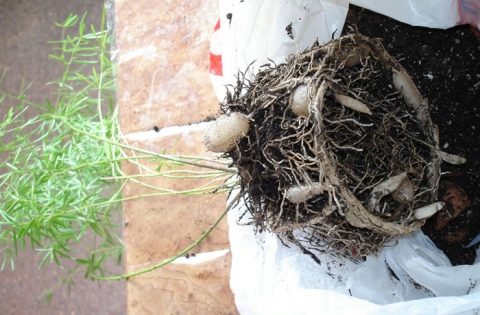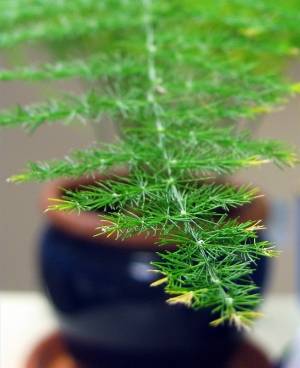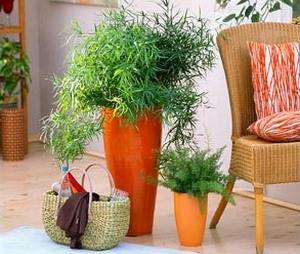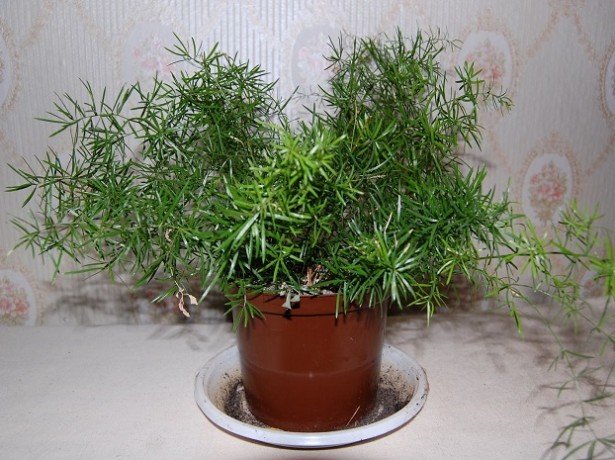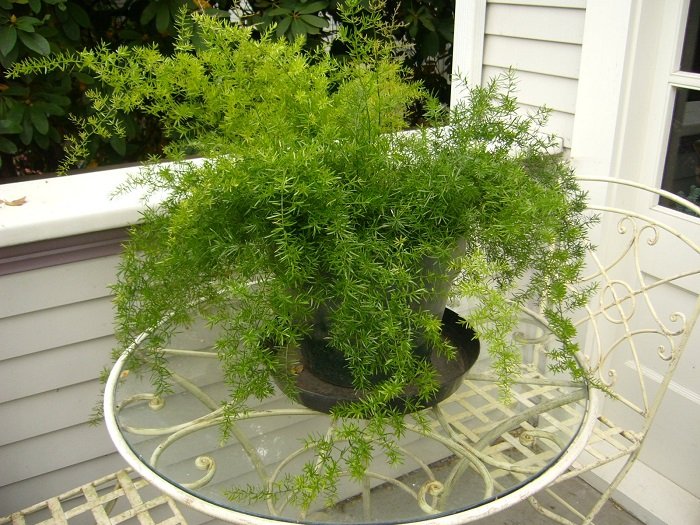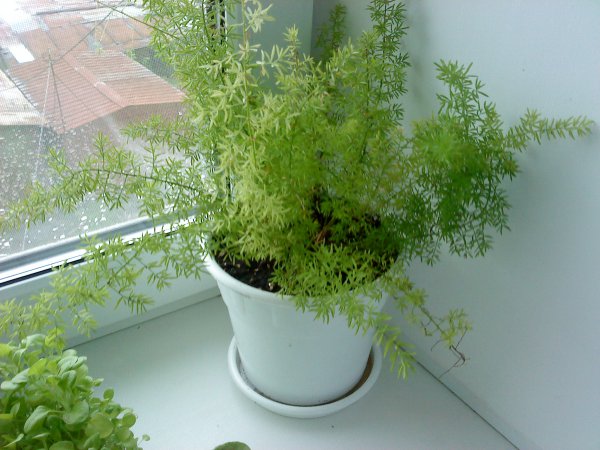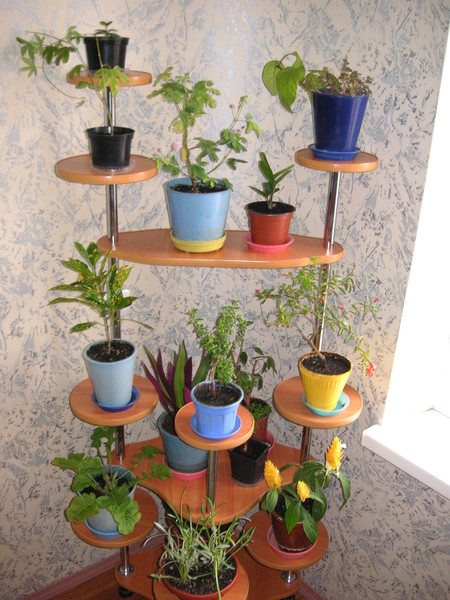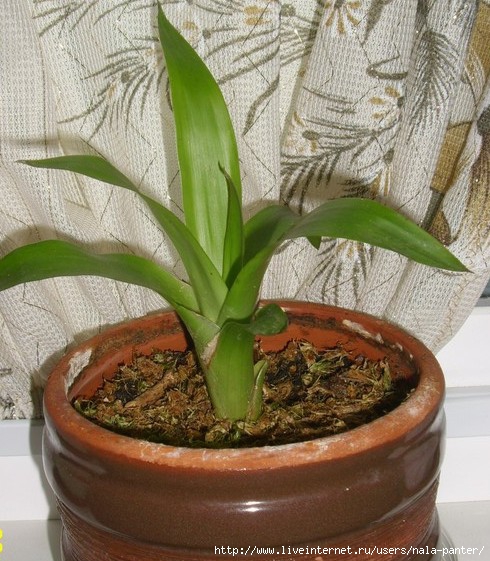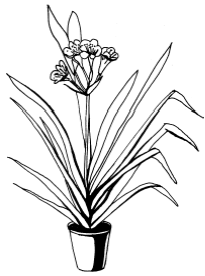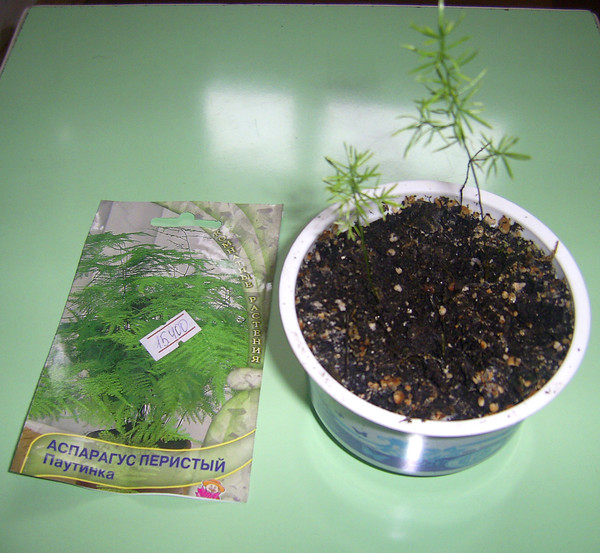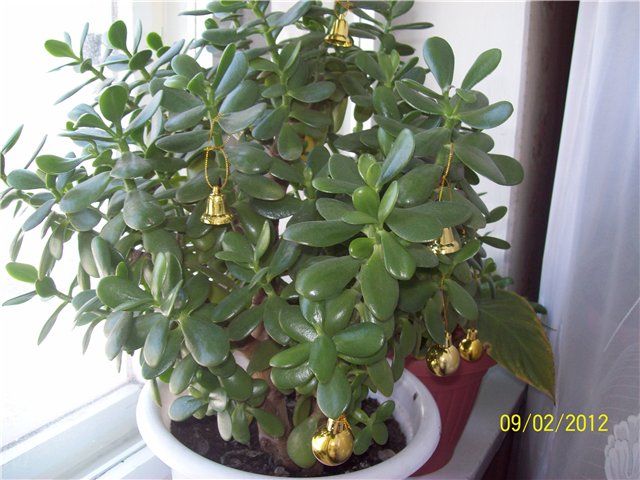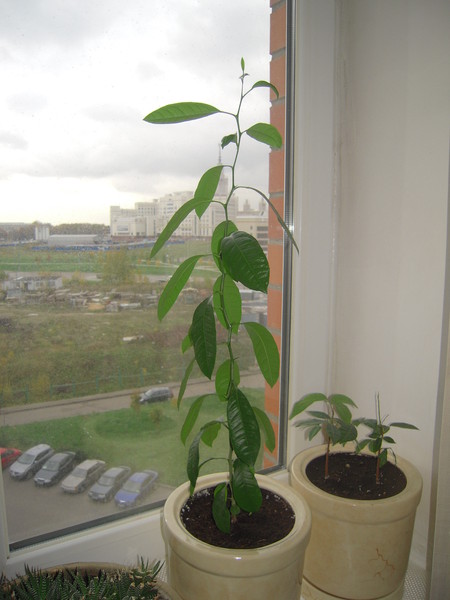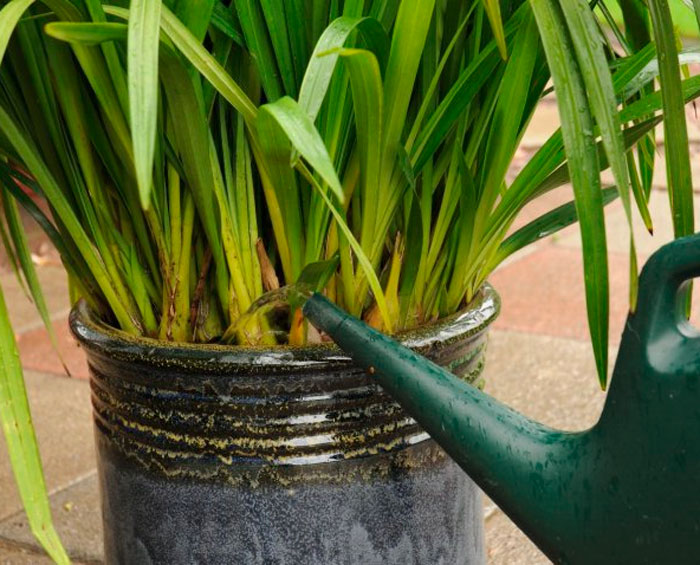Do asparagus need to be pruned and how to prune?
Many amateur flower growers are wondering whether it is necessary to periodically prune the overgrown asparagus, and whether such a manipulation will be useful. This procedure is necessary because it can help to achieve the best aesthetic results, increase the level of decorativeness of the flower.
It is worth pruning indoor asparagus in the spring. It is then that the plant has enough strength to renew and quickly replace dried old stems. After removing the "bald" branches, the flower actively releases young shoots, which give the bush more splendor and attractiveness.
Views
There are a lot of asparagus species, but flower growers highlight some of them that are ideal for landscape design and home decoration.
- Asparagus pinnate (setaceus) can be found in the halls of schools, banks, terraces and winter gardens. This species includes half-shrubs with non-pubescent and branching shoots. The leaves look like small triangular scales. In an adult plant over 10 years old, mainly paired white flowers appear, but there are also single small flowers. Asparagus pinnate needs light soil, timely watering. The flower grows in low light and at a temperature of +15 ° C.
- Asparagus Meyer can be grown both in the garden and as a houseplant. Bushes reach a little over 50 cm in height. The branches are straight, even, but can bend under their own weight. Small lateral shoots extend from the central stems, thanks to which Meyer's asparagus looks like an ovary of "fox tails". Very often this type is used to decorate bouquets. It is grown in wide containers, moisture stagnation is not allowed.
- Asparagus Sprenger is mainly grown as an ampel tree. It has long, weak stems, which sometimes exceed one and a half meters in length. The plant looks very beautiful when red berries appear after flowering. But only adult plants bloom. This view requires good lighting. In the shade, the branches will stretch, fade, and all decorativeness will be lost.
- Asparagus sickle is more often used in landscape design. Its emerald color perfectly sets off the greenery of other plants. It differs from other species in long and thick shoots, the length of which in the wild reaches 15 meters.
- Asparagus Mix is a collection of several types of plants. Buying such a kit, you can appreciate the decorative qualities of different types and it is easy to decide which one you like.
Asparagus care
In the second year after planting asparagus seedlings, mineral fertilizers are applied, then the soil along the rows of plants should be loosened as early as possible, trying not to damage the roots.
In dry weather, make sure that the soil under the plants remains moist. In dry soil, asparagus shoots become fibrous and taste bitter.
In October, drying asparagus shoots should be carefully cut off near the ground, being careful not to damage the rhizome, and burned. In plants that are not affected by rust and asparagus flies, the tops can not be cut off, it will protect the roots from freezing in winter
Asparagus seedlings in a nursery in severe frosts in the absence of snow or light snow cover should be covered with leaves, straw or manure.
In autumn, annual, biennial plantings and fruiting plants should be fed with superphosphate (0.3-0.5 kg per 10 m²) and 40% potassium salt (0.25-0.35 kg). After fertilization, the soil in the aisles is deeply loosened
This must be done carefully so as not to damage the roots and sprouts of asparagus.
Good results are obtained in autumn mulching with peat in a layer of 8-10 cm for better wintering.In early spring, the mulch is loosened and embedded in the soil as top dressing. This operation is performed annually.
In April, the soil poured in the form of swaths on the rows of fruiting asparagus should be carefully leveled and lightly tamped. This makes it easy to spot cracks in the soil above the asparagus seedlings (cracks indicate that the seedlings can be cut). The width of the rolls at the base in the first years of cultivation should be 40 cm, in the following years - 50-60 cm.
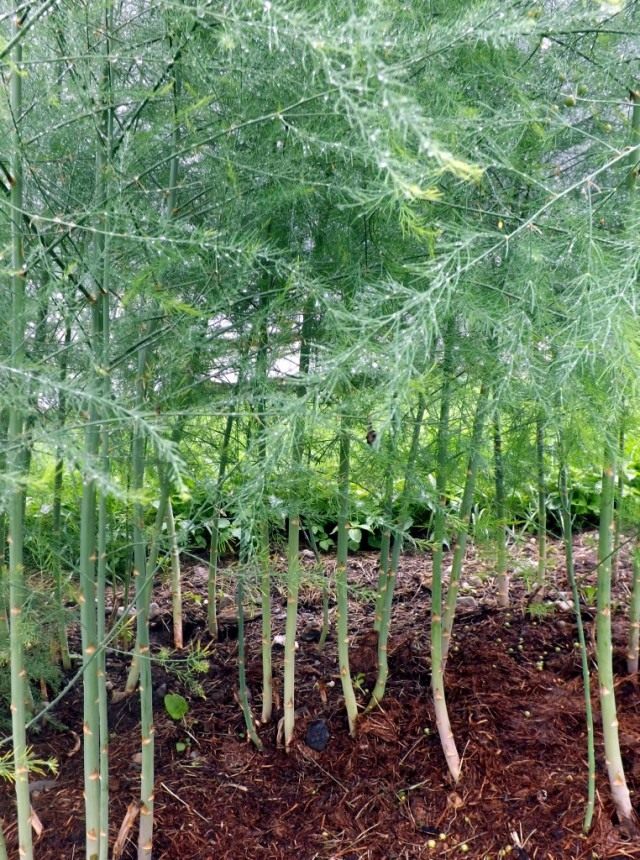 Asparagus. Gwendolyn stansbury
Asparagus. Gwendolyn stansbury
Asparagus transplant
You can move wild and garden asparagus to a new place in early spring or autumn, a month before frost.
The roots, strong and well developed, are a problem when transplanting - they are difficult to dig out. Therefore, the earth is watered abundantly, then they undermine the culture with a shovel or pitchfork from all sides and pull it out.
Interesting! The car factory "VAZ" uses a vegetable palette in the painting of cars. There are the colors "peach", the famous "eggplant" and bright red viburnum "asparagus".
Edible asparagus, garden and wild, is a common culture in the farmsteads and dachas of Russians. The plant has long become a familiar delicacy, a vegetable supplement in the diet of many families. Useful qualities, an abundance of vitamins and fiber were appreciated by nutritionists. Asparagus is grown as an ornamental and edible crop.
Distinguish between herbaceous, semi-shrub species and lianas. The flowers are unassuming, but the fruits are bright and beautiful.
The VAZ car plant uses a vegetable palette in painting cars. There are the colors "Peach", the famous "Eggplant" and bright red viburnum "Asparagus".
Reproduction methods
We recommend that you familiarize yourself
Reproduction of asparagus is done in 3 main ways: by seeds, cuttings and rhizome division.
The easiest way is seed propagation.

The seeds can be purchased at a specialty store or collected from a fruiting plant yourself. And they should be sown in January or April. Several seeds ripen in each berry of a fruiting plant. They must be collected and immediately sown into a moist light mixture of sand and peat, sprinkled and covered with transparent film or glass. Seedlings should be placed in a dark room with an optimal temperature of 20 ° C, and then regularly moisten and ventilate, preventing mold or soil from drying out. Under favorable conditions, the sprouts will begin to break through in a few weeks. Then the seedlings should be rearranged in a bright place. Young shoots are transplanted into pots after 3-4 months.
Propagation of plants by cuttings is also a common method. In early spring, shoots 8-10 cm long are cut off from the plant, rooted in containers with wet sand to a depth of 1-1.5 cm, covered with glass and placed in a warm, bright place. The sprouts should sometimes be moistened and ventilated. After 3 months, the plants will get stronger and give new shoots, then they can be transplanted into pots, continuing with normal care. Young shoots of some asparagus species, such as Sprenger, should be left in the box until the new season so they can take root better.
The most dangerous way is tuber propagation. Its essence lies in the fact that when transplanting, the plant is divided into 2 or 3 parts and planted in different pots. But the roots of the flower are quite delicate and easily damaged. As a result, the plant will either die, or, taking root, it will hurt for a long time.
What does asparagus plumose look like, which family does it belong to?
Asparagus plumosus, or pinnate (Asparagus plumosus) - evergreen perennial plant, belongs to the Asparagus family. Has a dense crown with many thin branched shoots. Foliage brings a special decorative effect, small plates are reduced and expressed in scales. Due to its unusual appearance, asparagus is popularly called the "spider web".

Asparagus pinnate was nicknamed "cobweb" because of the lush crown with thin stems
Common varieties
The most common and well-known varieties are:
- Meyer is a compact shrub with a branched crown;
- Crescent - grows in the shape of a liana and reaches a length of 5 meters;
- Sprenger is a low asparagus with long creeping branches and small paniculate inflorescences.
Healing properties
The content of beneficial elements in asparagus is almost identical to that of asparagus. Among the medicinal properties of the feathery variety are:
- normalization of the gastrointestinal tract;
- reduction of migraine headaches;
- removal of excess water and toxins from the body;
- removal of inflammatory processes.
Briefly about the history of appearance
Wild plumosus is found naturally in humid African forests. Like other species of asparagus and other asparagus plants, they were exported by botanical scientists to Europe, from where they spread throughout the world.
1. Seven Secrets of Success:
| 1. Growing temperature: a plant of moderately warm content, in spring and summer the temperature is considered ideal in the range from 16 to 24 ° C. In autumn, some plants should be transferred to a dormant state and the temperature should be lowered to 15 - 17 ° C. |
| 2. Lighting: Shade tolerant asparagus grows easily under artificial lighting. |
| 3. Watering and air humidity: at any time of the year, the surface of the substrate is dried between waterings a few centimeters in depth, the air humidity is high. |
| 4. Pruning: using sanitary pruning, all old branches are pruned at the base. |
| 5. Soil: tolerates a wide range of soil conditions as long as there is good drainage. |
| 6. Top dressing: monthly fertilization during the period of active growth; in winter, asparagus is not fed. |
| 7. Reproduction: dividing large specimens during spring transplantation, growing from seeds and cuttings. |
Botanical name: Asparagus.
Family
Where it grows. Plants originate from Africa.
What it looks like. Asparagus or asparagus is a herbaceous or slightly woody perennial evergreen. The long, curved stems are densely covered with short, needle-like leaves, giving this plant a sophisticated look. Has tiny thorns in the axils of the branches.
From a distance, asparagus looks very soft and fluffy due to its lovely, needle-like leaves.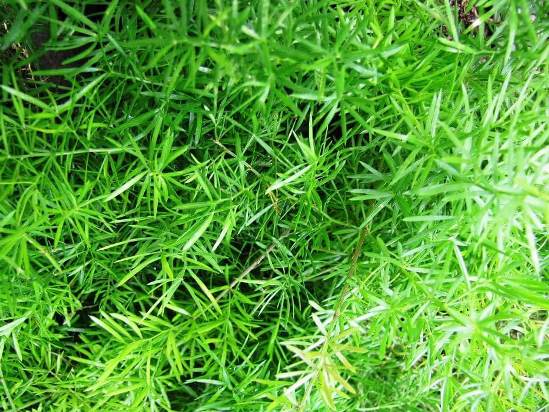
Adult plants bloom in summer with small white, greenish or pale pink, bell-shaped, highly fragrant small flowers, singly or in pairs. Each plant is capable of bearing both male and female flowers.
When flowers are pollinated, fruits are often formed - round green berries, which turn red as they ripen, the berries are poisonous. Each berry produces from 1 to 6 seeds.
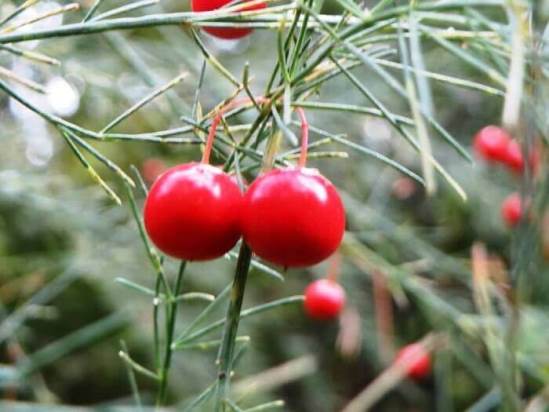
Height. Stems up to 100 - 150 cm tall.
Transplantation and reproduction of feathery asparagus
Asparagus has fast-growing roots, therefore, as already mentioned, a young plant is transplanted every year, and an adult every 2-3 years, while all dried shoots and part of the root system are removed. They are transplanted by the transshipment method, as it is less traumatic for the roots. The process takes place according to the following algorithm:
- Pick up a pot. In size, it should be slightly larger than the old one, but not too spacious, so as not to stimulate the roots to grow too actively, which will negatively affect the decorative appearance of the bush.
- Place a drainage layer on the bottom of the pot, pour a small layer of fresh soil mixture on top.
- Water the plant a couple of days before transplanting so that the soil is loose and easily removed from the pot.
- Gently remove the flower from the old container. Inspect for damage, trim with clean pruning shears and treat with crushed charcoal or other antiseptic.
- Taking care not to damage the roots, place the bush in a new pot and cover the remaining space with earth. Free space should be left up to the top of the pot, as the growing root system raises the soil higher.
- Drizzle with soft water and place in a warm, lit place.
Reproduction occurs by cuttings, dividing the root system and seeds:
- Cutting is the most difficult type, since with it the shoots take root poorly.
- Reproduction by dividing the roots is painful enough for a flower and is justified only for highly overgrown plants. It is carried out according to the transplanting algorithm, but after being removed from the old pot, the root system is divided into several parts and treated with an antiseptic. Small pots are selected so that the plant does not waste energy on growth, but can restore the roots. Small bushes can hurt for a long time after transplanting and require very careful care.
- Getting new plants from seeds is a fairly common method. The seeds can be purchased from the store or harvested from the overripe fruit of the flower if flowering can be achieved.
Sown according to the following algorithm:
- soak the seeds in a solution of potassium permanganate for 3 days;
- pick up a wide sowing container;
- prepare a soil mixture - shop soil for ferns is well suited;
- immerse the seeds at a shallow depth;
- pour over with warm soft water;
- cover with film, which must be removed for a short time every day for airing;
- put in a warm place with diffused light;
- seedlings will appear in a month;
- when their height is about 15 cm, they can be transplanted into pots.
What if the asparagus turns yellow?
Yellowing or shedding of modified leaves is a common cause of concern for novice growers. To prevent this phenomenon, you need to understand which factor or their combination influenced it.
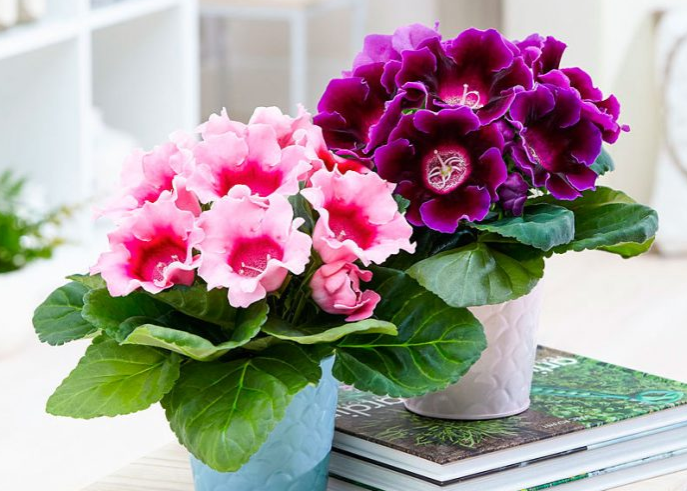 You may be interested in:
You may be interested in:
Gloxinia: home care, transplantation and reproduction, diseases Gloxinia is a very graceful and delicate plant. It fits perfectly into any interior. How to care for this delicate ... Read more ...
Such care errors can provoke a yellowing of a flower:
Lack of proper watering. Regular watering is important, but it all depends on the season, temperature and humidity in the room. You need to watch out for the earthen lump. Drying it out will lead to unpleasant consequences. To avoid this, growers can admit the other extreme - they fill the flower. And this leads to the same result, because when the roots rot, the plant can also turn yellow and even shed its leaves.
Lighting errors. Bright, direct sunlight burns the foliage, causing it to turn yellow and fall off. Dim lighting is also harmful - the plant loses its decorative appearance and begins to fade
It is important that a sufficient amount of diffused light falls on the plant. While staying on the street, a shaded location is also selected, without direct light hitting the bush
Reduced air dryness. Asparagus is native to the tropics, so dry air immediately affects the beauty of the leaves - they begin to curl and dry out. To ensure a comfortable environment, you need to irrigate the flower regularly and monitor the humidity level in the room.
Insufficient fertilization. Asparagus is fed almost all year round. This provides a rich color and density of the crown. When the plant does not receive enough nutrients, this affects the decorative effect. The leaves turn yellow and thin out. Irregular transplant. The root system grows very quickly and takes up the entire area of the pot. This leads to the fact that growth slows down, nutrients are lacking and the bush begins to turn yellow and shed its leaves. For adult flowers, a transplant is enough once every 3 years, and young flowers need to be reloaded annually, since they are actively growing.
Transplant recommendations
Young plants must be transplanted every year. For adult plants, once every 2-3 years is enough. The planned transplant of asparagus is carried out in the spring.However, if the plant is not purchased from a store, it should be transplanted right away to protect it from pests that may be in the soil. The transplant can be omitted if the plant does not turn yellow and does not lose foliage.
For transplanting, it is necessary to prepare a pot of slightly larger diameter than the previous one. Expanded clay drainage should be laid at the bottom. You can use the usual method of handling the plant without affecting the rhizome. But it is better to update the root system of the flower: free it from the substrate and process it, cutting off the bare old branches, removing the overgrown tubers. Removing branches and tubers stimulates the emergence of fresh shoots well.

The mixture for replanting should include leafy and humus soil with the addition of sand and turf. The roots of the plant are placed in the center of a new pot and sprinkled tightly with a pre-prepared substrate, but not higher than the previous level, because over time the rhizome will grow and slightly raise the soil. The transplanted flower is watered, and after a week it can be fed with complex fertilizers. Once a month, the soil in the pot must be loosened.
Asparagus bloom
At home breeding, the culture can rarely bloom. The flowering period in this case falls on July-August. Flowers are single and collected in a brush.
In biological structure, they are identical to the flowers of a lily, but very small. That is why the culture was previously referred to as liliaceae. The pastel white flowers have a delicate scent.
On one plant, flowers are of both sexes.
Interesting! If you gently transfer pollen from the stamen of one flower to the pistil of another with a soft brush, the plant will bear bright red fruits.

Flowering and fruiting of asparagus
When the plant begins to bloom, special attention should be paid to soil fertility, the frequency of watering and top dressing, and adherence to the summer care regimen.
Transplanting and pruning a plant
All asparagus species are characterized by rapid growth rates in the early years. Before the plant turns 4-5 years old, it is necessary to transplant annually, mature - once every 2-3 years. The most optimal time for this is the first half of spring.
After abundantly wetting the soil, holding a knife along the walls of the container, you need to pull out the bush with the maximum amount of soil. Too long, decayed, damaged roots should be removed. Also, at the same time, extra tubers are cut off.
It is necessary to pick up a container a couple of centimeters larger than the previous one, lay a drainage layer in it by a third of the height. Next, you should plant the plant, sprinkling it with a soil mixture consisting of turf, humus, leafy soil and sand. The bush needs to be well watered, after a week or two, top dressing.
Note! Simultaneously with the transplant, the asparagus is pruned. At the same time, old, yellowed, damaged, diseased stems, devoid of foliage, are removed
Asparagus fell ill: identifying the cause
Greenhouse thrips
Flying insects can grow on asparagus, which lay eggs on its shoots and leaves. But the greatest harm is not adult insects, but their larvae, because they use young shoots, leaves and asparagus juice for food. Because of this, he begins to gradually weaken, dry and lose his attractiveness.
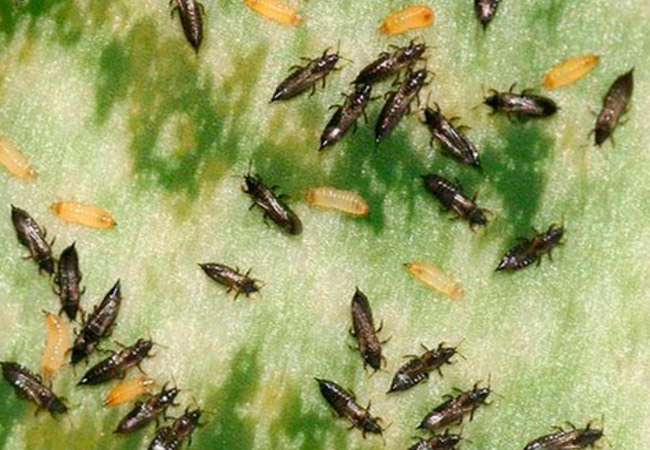
To restore health and beauty to the plant, you can only get rid of the thrips that have settled on it. For this purpose, you can use special chemicals, for example, karbofos. It has proven itself well in the fight against greenhouse thrips.
Plant treatment should be carried out until the pests completely disappear. We process the plant 2-3 times a month.
Shields
On the shoots and the lower part of the plant, scale insects may appear, for which asparagus juice serves as food. This also leads to its gradual fading. Even young shoots begin to turn yellow and leaves fall off. In addition, the scale insect is capable of laying eggs on the plant. In a warm room, the appearance of larvae will not be long in coming.

When scabbards appear on asparagus, you should act promptly: immediately you need to thoroughly wipe the plant with alcohol or a solution of laundry soap, and after a few minutes, rinse it well.
Of course, for asparagus, this method may not give the desired result - it will be too difficult to wash out its needles. In this case, you can resort to using special chemicals to combat insects. Treat the plant, repeat it after 2 weeks. Usually scale insects die after the first treatment.
Gray rot
If the temperature is violated, gray rot may appear on the asparagus. This usually happens at the end of autumn. It appears as a gray bloom that appears on the fruit. This creates a moldy and damp smell. A gray bloom forms on the fruit.

Dealing with this problem is quite simple. It is only necessary to normalize the temperature in the room, and treat the plant with copper oxychloride.
Care errors
If the asparagus crumbles, what to do in this case? The answer is obvious - just eliminate the reasons that led to this. The plant will come to life again and new leaves will grow on it quickly enough.
With insufficient watering and a small amount of fertilizer in the ground, asparagus leaves can acquire a yellowish tint, and then completely crumble.

- Low indoor temperatures can also be the reason why asparagus turns yellow and crumbles in winter. In this case, place the plant pot closer to the heat source. But we take into account that asparagus prefers humid air and placing it close, for example, to a radiator, is not recommended.
- If the asparagus is regularly overheated in the sun or lacks moisture, it will also crumble.
- With frequent or abundant watering, the root of the plant can be rotted. This is a rather dangerous disease that can cause the death of asparagus. To prevent this, water the plant not too often and observing all the rules.
As you can see, you can almost always "revive" asparagus, even if it turns yellow and crumbles, the main thing is to do it in a timely manner and correctly. With proper care, the plant will delight you with its beauty and will be an excellent decoration for your home.
Pests and diseases
Asparagus rarely get sick. The main problems are associated with changes in temperature, lighting and watering. If brown spots appear on the leaves of the plant, it means that the flower has come under open sunlight. Pale leaves and elongated shoots indicate a lack of light. If the leaves turn yellow and begin to fall off, it means that the watering regime or temperature is violated. Excessive watering leads to rotting of the root system and wilting of the flower. A disease such as gray rot, which manifests itself as a fluffy gray bloom on the branches, can also develop. In this case, you will have to use chemicals, in particular copper oxychloride.
Of the pests, the flower can be threatened by the scale insect, thrips, aphids, and ticks. In the fight against them, an acaricide solution is used, treating the crown 2 times with an interval of 2-3 days. Wax shchitovtsy are removed by processing the crown of the flower with a cotton swab dipped in alcohol. In the fight against the scabbard, a soap solution helps.
But we must remember that asparagus does not tolerate chemicals, so the plant should be monitored to prevent contamination. And if pests have appeared, then you should get rid of them at a very early stage without the use of chemicals.
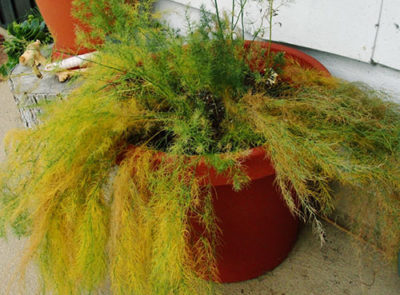
Origin and varieties
Africa is considered the homeland of Asparagus, but it is distributed almost all over the world. It belongs to the Asparagus family, there are poisonous and medicinal varieties. There are almost 300 species of diverse and dissimilar plants, but only a few species survive at home.
Asparagus pinnate is a perennial and small plant. The stems can be up to 1 meter long and are curly or straight. In appearance, the flower is a little openwork, because the branches are covered with hard needles.Blooms single or collected flowers of white, blue-black berries.
Asparagus crescent is a liana that reaches a length of 4 meters at home. The cladodes are narrowed, sickle-shaped. Blooms with white flowers.
Asparagus Meyer is a decorative species. There are a lot of thin needles on the stems, which makes it seem fluffy. It blooms with white flowers and has red berries.
Asparagus is the thinnest - similar to pinnate Asparagus, but has longer stems (6-7 m).
Asparagus asparagus - differs from other species in that it looks like a herbaceous vine up to 3 meters long. It blooms with white flowers with a very pleasant aroma, which then turn into berries.
Asparagus Sprenger - has long branches, can grow like a huge dense-flowered shrub. Outwardly, the flower is somewhat reminiscent of a lily. The flowers are pink, white or yellow and are very similar in shape to small stars. The leaves can resemble the shape of lianas, although the needles give the plant some severity, they are actually very pleasant and delicate to the touch, so very often asparagus branches are used to decorate bouquets and create compositions.
It is imperative to remember that the berries of this plant are poisonous, they are strictly forbidden to taste, so you should think about buying a plant if there are small children in the house.
Feathery asparagus care
Observing certain rules, you can grow a stunningly beautiful, lush plant.
Lighting. There should be a lot of light on the asparagus, but the light should be diffused, since the direct rays of the sun can harm the leaves of this plant. The best places for him are the east and west windowsills
In the summer, it is sometimes advisable to take the pot with the plant out into the fresh air, but you need to be careful to accustom the asparagus to the street - starting with a few minutes a day and gradually increasing the time.
Temperature is very important for feathery asparagus. In summer, it is necessary to maintain the temperature around 22 degrees.
If it gets much hotter, the asparagus can start to hurt, shed its leaves, dry out and even die. In winter, the plant needs coolness - about 15 degrees. If the room is much warmer, you will have to spray it more often.
Air humidity. Asparagus should be sprayed regularly, especially in winter when air-drying radiators are in operation.
Watering. Drying out of the soil has a detrimental effect on the condition of asparagus, so it should be watered abundantly in summer. In winter, the frequency of watering depends on the room temperature. If the room is cool enough, you need to water much less often, but the earth should still not dry out.
Top dressing. It is necessary to fertilize asparagus pinnate at least twice a month, starting in spring and ending in autumn. For feeding, you can use such liquid fertilizers as "Rost-Hyacinth" or "Rainbow". You don't need to feed asparagus in winter.

